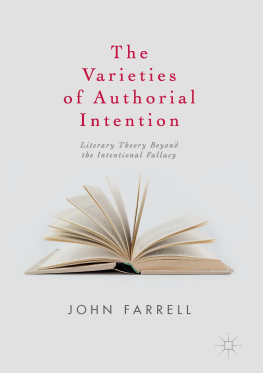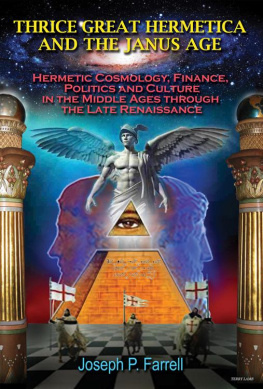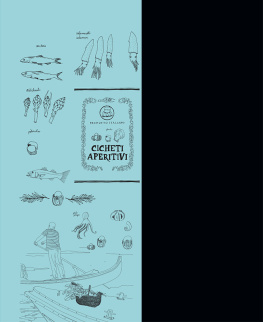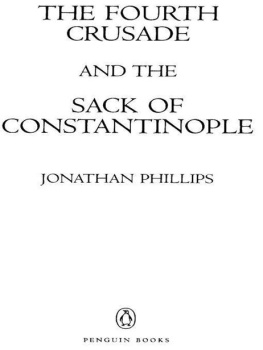Other Books by Joseph P. Farrell:
Covert Wars and the Clash of Civilizations
Saucers, Swastikas and Psyops
Covert Wars and Breakaway Civilizations
LBJ and the Conspiracy to Kill Kennedy
Roswell and the Reich
Nazi International
Reich of the Black Sun
The S.S. Brotherhood of the Bell
Babylons Banksters
The Philosophers Stone
The Vipers of Venice
Secrets of the Unified Field
The Cosmic War
The Giza Death Star
The Giza Death Star Deployed
The Giza Death Star Destroyed
Transhumanism (with Scott deHart)
The Grid of the Gods (with Scott deHart)
Thrice Great Hermetica and the Janus Age
by Joseph P. Farrell
Copyright 2014
All Rights Reserved
ISBN: 978-1-939149-33-6
All Rights Reserved
Published by:
Adventures Unlimited Press
One Adventure Place
Kempton, Illinois 60946 USA
auphq@frontiernet.net
www.adventuresunlimitedpress.com
Cover by Terry Lamb
10 9 8 7 6 5 4 3 2 1
To My Friends:
Scott Douglas deHart:
For conversations about beauty, music, poetry, and good things:
Thank you is not enough;
You are a true

George Ann Hughes,
For many comforting and encouraging hours of conversation,
And to
Tracy S. Fisher:
You are, and will always be, sorely missed.
A CKNOWLEDGEMENTS
This book is really a book that had many contributors, dating all the way back to the period that I was teaching medieval history in college. There, many students noticed things in our textbook which, due to the exigencies of trying to maintain a job, could not be addressed in an academic setting. It is therefore in thanks to them that this book is in part dedicated.
A word of thanks is also due to my good friend Dr. Scott D. de Hart, for many conversations over many years on the topics addressed in this book, not the least was, years ago, a lengthy conversation between us on our mutual impressions that we kept bumping up against hidden forces in our respective ecclesiastical establishments. It was a conversation Ill never forget, and in many respects gave added impetus to pursue the avenues of dot-connecting presented here. Ive seen fit to include an observation concerning his own thoughts and the speculations of many others that he brought to my attention at the very end of this book, when the full impact of it will, I hope, affect the reader as it did me when he first drew my attention to it. Like all obvious things, sometimes a huge secret is hidden plainly, out in the open.
As always, I owe a big thank you to my dear friend George Ann Hughes, for conversations on these and other subjects, and for her constant and prayerful support.
As always, a big thank you is due to my many readers for your thoughts and encouragement.
Joseph P. Farrell
From somewhere, 2014
P REFACE:
T HE J ANUS A GE
To a few of the Knights Templars, who were initiated into the arcana of the Druses, Nazarenes, Essenes, Johannites, and other sects still inhabiting the remote and inaccessible fastnesses of the Holy Land, part of the strange story was told. The knowledge of the Templars concerning the early history of Christianity was undoubtedly one of the main reasons for their persecution and final annihilation.
Manly P. Hall
F ROM ANY PERSPECTIVE, The study of the Middle Ages through the Renaissance and Reformations, and on into the early Enlightenment can be a daunting and confusing task, so daunting and confusing, in fact, that many throw up their hands either in boredom or despair (sometimes both) trying to make sense of it all. Even from a purely academic approach, one is confronted with a whirling zoo of facts, all copulating with each other and multiplying interconnections like rabbits; dukes, dynasties, princes, kings, emperors, doges, and dowagers marry and intermarry with dizzying frequency; alliances between great and ancient houses and nations and city states are formed and reformed over the course of conflicts that can literally span a century or more; three great monotheisms contend for cultural supremacy in the Middle East and Iberia; philosophers and theologians and scientists and artists debate endlessly, and the boundaries between them are all deliberately obscure; and, on top of all of this, various academic approaches are adopted as modern specialists in law, or finance and economics, political science, theology, sociology, philosophy, the history of science, all sift through the mountains of data, scratching out the stories of how the Middle Ages saw the foundation of the contemporary Western civilization in all these areas (and then some). The nation-state, the corporation, banking, even to a certain extent modern science, art, and music, all saw their birth during the high Middle Ages, and their growth and perfection into their modern forms during the Renaissance and early Enlightenment. One often comes away from such studies with more questions than answers, and into this gap have inevitably stepped those who seek to read between the lines to discover deeper forces and conspiracies at work. This book is no exception.
The period of the Middle Ages to the early Enlightenment was a magical working, as hermetic magic was practiced on a continental scale, and exerting its influence in all the arts. The period was, in short, the Janus Age of western history, looking back to a classical and religious past and back even further into remote Hermetic antiquity in Egypt, and forward to a Hermetic and increasingly secularized future, the future brought to pass by the Renaissance and culminating with the Enlightenment.
The period from the Middle Ages to the early Enlightenment does not disappoint, for there were at work an abundance both of deeper forces in the form of a rich underground stream of alchemy, Kabbalah, and Hermeticism, and of movements involving all of these and more. These coalesce where we begin the story: in the celebrated monastic-military order of the Knights Templar. In them, or rather, in the controversies and debates that have surrounded them both in their time on down to our own, two grand movements of human history are symbolized and summarized: the first, the movement from high antiquity and a culture based on nature and natures God, to the revealed monotheisms; and the second phase, the movement from the latter back to the former. In this, too, the age is the Janus age, constantly challenging us to look not only at the prosaic facts, but beneath them, beneath surface currents of monotonous and unimaginative academic histories, and to speculate and connect dots, for there are deeper currents at work, and some academic denials notwithstanding, there are dots to connect and there are conspiracies at work.. It was a Janus age, because to perceive it accurately, one has not only to look at the surface, but beneath it, connecting the dots that reveal the deep currents at work.
In the Templars, the two phasesor perhaps one should say, two facesof the Middle Ages meet, the first phase reaching its zenith in the formation of the Order, the second beginning with its demise, for as some have pointed out, the demise of the Templars is followed within a mere century by the very prominent rise and public display of esotericism and Hermeticism in all its forms. Indeed, as the internationally famous esotericist Manly P. Hall quipped, the Knights Templar were suspected of anything and everything,
















